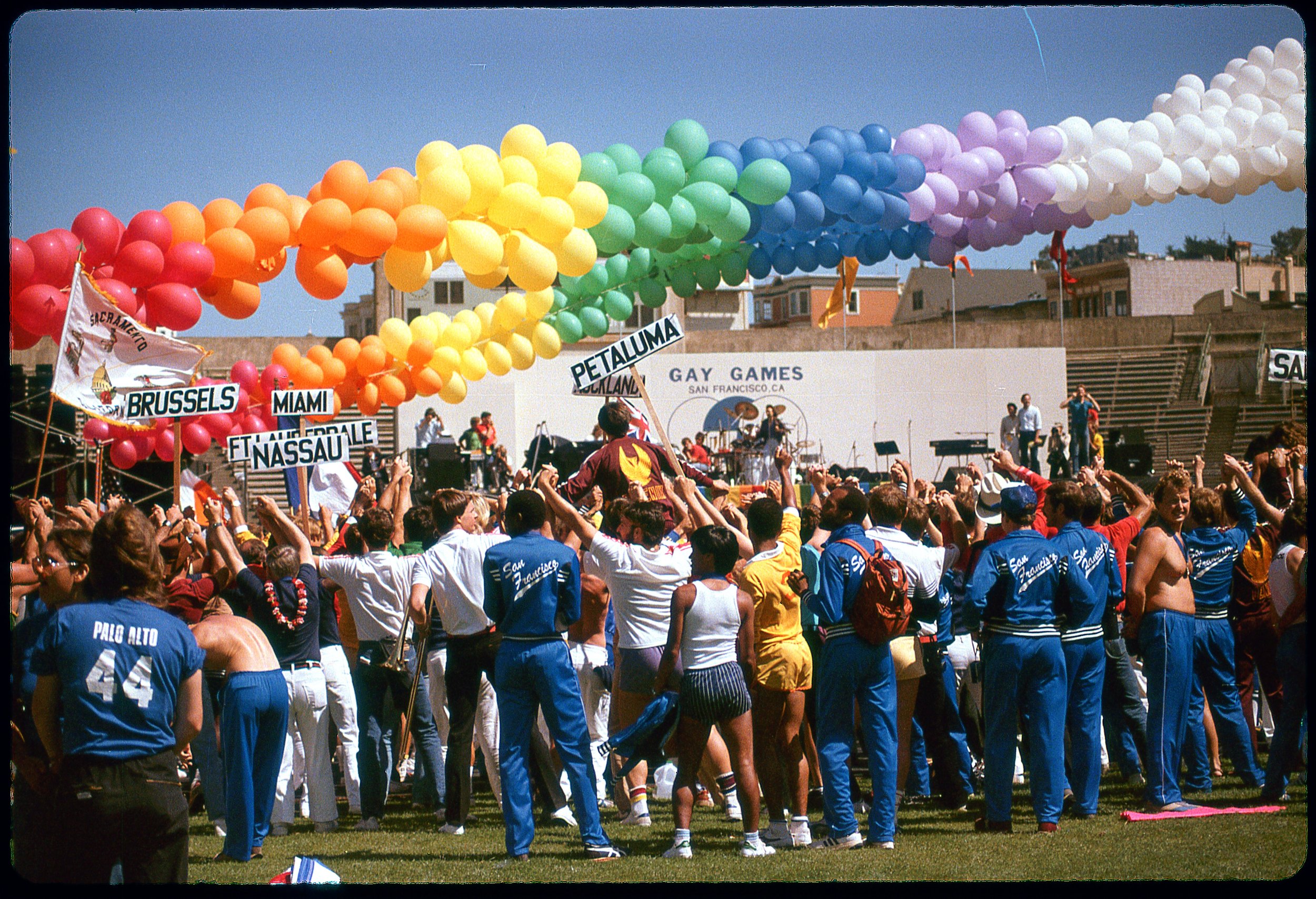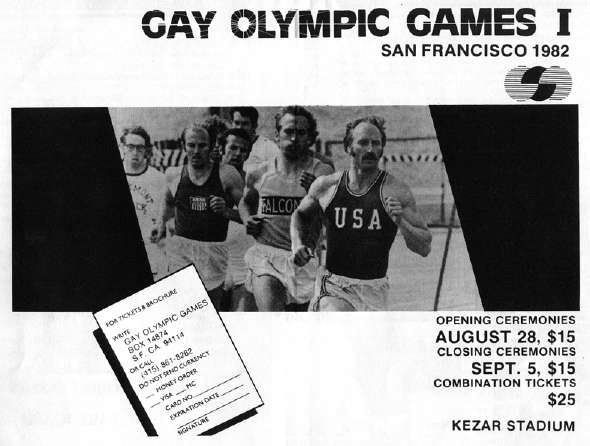
Passing the Torch
3.
Creating San Francisco Arts & Athletics: Laying the Foundations
The initial concept to have a sports and cultural festival open to all was born when Dr. Thomas F. Waddell walked into the Stadium on 12 October for the Opening Ceremony of the Mexico City 1968 Summer Olympics as a member of the U.S. Decathlon team. As he would often state, he felt as if his heart was going to burst; and that it was something everyone should experience. In the end, it wasn’t about where he finished, but the fact he had participated and did his best.
Mark Brown, back row at right. Chris Puccinelli, front row second from right
MARK BROWN: When Tom first approached me about a “Gay Olympics,” I said no. He approached me a year later, and given his ability to persuade and manipulate, I said yes – even though I wasn’t sure we could pull it off.
The original San Francisco Arts & Athletics Board included Tom as President, myself as Secretary-Treasurer, Hydie Downard and Chris Puccinelli as Vice Presidents, and Mike Evans as our lawyer. Paul Mart didn’t want to be on the Board, but he did a lot of international travel and got the word out for us that way.
Tom was often out of town on business, so the day-to-day operations fell to the others. We were the ones who had the connections in the community - Chris, through her Awards by Chris sports store; Hydie, through softball, the Imperial Court and her bartending job at Twin Peaks in the Castro; and I. By this time, I had also secured the offices, giving us a presence in the heart of the Castro.
Zohn Artman on Castro Street
Things changed once Zohn Arman got on the board. He was a promoter, so everything he did was from that point of view. He certainly knew how to promote Tom as the head of the Gay Games. I do think Tom had greater intentions beyond the Games, and Zohn was the type of person Tom needed to achieve those goals.
When they scheduled the press conference about the Gay Games with Mayor Dianne Feinstein, they requested for it to take place outside, on the City Hall steps. Feinstein, probably seeing Tom as a potential rival in the next Mayor’s race, chose to have it take place inside, in the rotunda.
GENE DERMODY: The Gay Games entered into a social vacuum with a very attractive and inclusive registration menu of sports. There were no qualifying events, no seeding, no health restrictions, no drug testing, and more categories across age, gender, weight, and skill level. The events were open to EVERYONE, and organizers made sure you were accommodated. Typical medal competition took a back seat to connection and inclusion. Add to that San Francisco was an LGBTQ+ dream destination, and it was perfect. Given that there was no internet, no email, and no mainstream media advertisements, people still came from all over the world, thanks to the word-of-mouth travel promotion by Gay Games pioneers such as Paul Mart.
The Red Book
Jean Nickolaus Tretter in 1983
JEAN-NICKOLAUS TRETTER: Team Minnesota started organizing in the Fall of 1981. In the January 1982 newsletter published by San Francisco Arts & Athletics, there was a notice for those wishing to help organize an international governing body to perpetuate the Gay Olympic Games Movement, including selecting where the event would be held each quadrennial. I answered that notice and began a long-distance working relationship with Tom Waddell.
Early in 1982, Tom asked me to contact all the various national sports governing bodies in order to develop rules and regulations for the Gay Olympics. With only a telephone and the U.S. postal service as my tools of access, I was able to secure the various rules from each sport’s governing body, as well as additional guidelines from the United States Olympic Committee.
I took each set of rules and did as minor an adaptation as possible on each of them, in order to be more accommodating, particularly regarding gender identity. This initial collection of rules and regulations became known as the Gay Games Red Book, which has grown, expanded, and adapted over the years, when necessary.
The same January 1982 news bulletin also mentioned a national torch relay. The only problem was, they only had relays scheduled on either coast, with nothing established across the Midwest or Rocky Mountain states. But that’s another story.
Left to right: Founders Mark Brown, Tom Waddell, Harriman Thatcher, Paul Mart
GENE DERMODY: In 1988, about eighteen months prior to the Vancouver Gay Games III Opening Ceremony, in frustration with the total lack of confirmed information necessary for me to promote wrestling, I had written a scathing letter to the editor to the “Village Voice” in New York City. Specifically, Vancouver organizers had not applied for a Canadian Wrestling Event Sanction. Wrestling had to be sanctioned in order to get insurance and officials. Given the San Francisco history, it should have been an easy fix. But there was resistance with the Vancouver organizers. However, to not continue this sanctioning was financially, politically, and operationally unacceptable; the wrestlers would simply not register. Vancouver also had not reserved a gymnasium and had not acquired wrestling mats. This was resolved when we arrived after intense negotiations and resources to rent (and move) the mats from Simon Fraser University.
Vancouver was operationally overwhelmed. Team NY’s FGG delegate, Physique champion Tom Cracovia, and I met during the week in Vancouver to discuss the complaints that were being directed at us as Gay Games sport organizers. What emerged was a plan to convince the FGG to codify and require the Sports Requirements for a Gay Games Host (the eventual “Red Book”). We would then lobby the LGBTQ+ sport governing bodies before the 1991 FGG Meeting, and at least make people aware of the need.
There actually was FGG resistance to having the LGBTQ+ Sports Governing Bodies making demands of the Host without it being in the License Agreement. Gay Games pioneer and LGBTQ+ activist, Rikki Streicher, specifically objected to emulating the non-Inclusive Olympics Sport Policies of the USOC. In fact, there was even resistance to the FGG taking on more LGBTQ+ sports organizations as members for the same reason; the anti USOC furor was still that strong.
At the 1992 FGG Meeting our efforts with getting the FGG to approve a Required Code of Gay Games Sport Rules (the “Red Book”) was beginning to gather steam. LGBTQ+ sport governing bodies for Aquatics, Tennis, Bowling, Martial Arts, Wrestling, et al just went ahead and published their own Championship Rules, and received good operational cooperation from the Gay Games IV organizing committee.
However, it would take the strong leadership of two new FGG Delegates to manage the projects for a better ProForma License Agreement with an integrated Required Code of Athletic Rules (“Red Book”) to guide the Hosts.
Teresa Galetti of Philadelphia brought an expertise to Sports Committee from Martial Arts for resolving so many issues where Gay Games values were in conflict with standard sports sanctioning requirements at that time. It was exactly what Rikki Streicher had recommended.
Sydney Australia’s Richard Cobden brought an extraordinary international legal perspective to the License Agreement project from his intellectual property & copyright expertise before the Australian Supreme Court. He created the framework for legally integrating the “Red Books” into the ProForma License Agreement.
Their joint efforts made this new “Red Book” contractually enforceable with the Host within the License Agreement. It was a monumental task that took over a year. It was overwhelmingly approved and ready for the 2002 Sydney cycle and the 2006 Gay Games cycle that saw the Montreal / GLISA / Chicago drama. The “Red Book” was designed to be a work in progress, and constantly enhanced as issues like gender identity, age, disability inclusion, drug testing, and overall mission adherence kept resurfacing.






